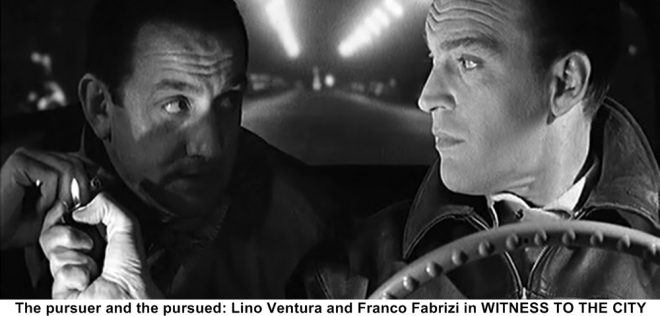Tags
Á double tour (Web of Passion), Breathless, Claude Chabrol, Jean-Luc Godard, Jean-Paul Belmondo, Les tricheurs (The Cheaters), Marcel Carné, Roxie Theater, The French Had a Name for It

“The French Had a Name For It,” Don Malcolm’s festival of Gallic noir returns to San Francisco’s Roxie Theatre, Nov. 12-14, but on Sunday, Oct. 24, he serves up an appetizer with two tribute double bills. In the evening, Malcolm pays homage to the great Jean Gabin with screenings of two of the actor’s best, the 1954 heist film Touchez pas au grisbi (Hands Off the Loot!), and Des gens sans importance (People of No Importance), a 1956 drama limning the affair between Gabin’s middle-aged truck driver and a young waitress (François Arnoul). The afternoon belongs to Jean-Paul Belmondo with two films that capture the actor’s formidable charisma just before he achieved stardom with his breakthrough in Jean-Luc Godard’s Breathless.
Belmondo’s role is but a small supporting part in Marcel Carné’s Les tricheurs (The Cheaters), a drama about the star-crossed romance between a bourgeois suburbanite (Jacques Charrier) and a hipster existentialist (Pascale Petit). A superb jazz and early rock ‘n’ roll soundtrack that features, among others, Chet Baker, Fats Domino, Lionel Hampton, Dizzy Gillespie, and The Champs propels the action that moves from cafes to the luxurious apartment of one particularly well-heeled member of this demimonde to a club on the Champs-Élysées.
Belmondo makes a striking entrance, rifling through coats at a party, then moves in and out of the action. He rivets the screen in the scenes that he is in – that he is destined to be a star is hardly surprising.
The second feature in the tribute is Á double tour (Web of Passion), Claude Chabrol’s third feature, which begins as the study of a dysfunctional upper-class Provence family before shifting in a murder mystery as Henri Marcoux’s (Jacques Dacqmine) young artist mistress Leda (Antonella Luadi) comes to a bad end. And while Roger (Mario David), the village milkman, is arrested for the crime, there is a whole houseful of suspects at the Marcoux villa to consider.
Belmondo is Laszlo Kovacs – the alias the actor’s character Michel would later adopt in Breathless – tactless, gross fiancé to Henri’s daughter Elisabeth (Jeanne Valérie). He is the man who introduced his future father-in-law to Leda, an old friend. He delights in taunting Elisabeth’s mother Thérèse (Madeleine Robinson) with his boorishness and recognizes that Elisabeth’s classical music-obsessed brother Richard’s (André Jocelyn) is more than simply eccentric. He’s a pig, cheerfully so, but when it comes to toxic masculinity and misogyny he’s a rank amateur compared to Papa Marcoux.
Call this double bill “Baby Steps to Belmondo,” as what both films offer are striking glimpses into what Godard saw when he cast the actor in Breathless. The rough-hewn magnetism is there. It was just awaiting the director who would fully exploit it. –Pam Grady
Á double tour (Web of Passion), 2:00PM; Les tricheurs (The Cheaters), 3:45PM, Sunday, Oct. 24, Roxie Theater, 3117 16th St, SF. www.roxie.com

 When Charles Aznavour died just over a year ago in October 2018, it brought the end of not just one of the world’s great singers but also an actor of considerable charisma. That quality is on full display in The Fabiani Affair (1962), a tense crime drama that is one of 15 1960s Gallic film noirs screening at The French Had a Name For It 6, Thursday, Nov. 14-Monday, Nov. 18 at San Francisco’s Roxie Theater.
When Charles Aznavour died just over a year ago in October 2018, it brought the end of not just one of the world’s great singers but also an actor of considerable charisma. That quality is on full display in The Fabiani Affair (1962), a tense crime drama that is one of 15 1960s Gallic film noirs screening at The French Had a Name For It 6, Thursday, Nov. 14-Monday, Nov. 18 at San Francisco’s Roxie Theater.

